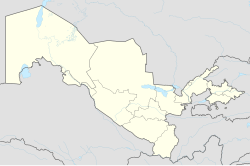Qo'qon
|
Qo'qon Қўқон |
||
| Russian : Коканд (Kokand) | ||
|
The Khan Palace in Kokand |
||
| Basic data | ||
|---|---|---|
| State : |
|
|
| Province: | Fargʻona | |
| Coordinates : | 40 ° 32 ' N , 70 ° 57' E | |
|
|
||
| Height : | 409 m | |
| Residents : | 233,500 (2014) | |
Qoʻqon (Uzbek-Cyrillic Қўқон, Russian Коканд Kokand ), also known as Kokand in German , is a city in Uzbekistan with 221,700 inhabitants (as of 2010).
history
The city used to have a key position at the entrance to the Fergana Valley . It is located on the important Silk Road , a caravan route that connects the Mediterranean with East and South Asia. Mongolian troops destroyed the city in the 13th century .
The modern city developed from a fort built in 1732. In 1740 the town became the capital of the Kokand Khanate . The khanate was at its greatest extent in the first half of the 19th century, when it comprised parts of what is now Kazakhstan . At that time, Qo'qon was a major trading center with more than 300 mosques.
In 1876 the Russian army captured the city. Qo'qon became part of the Russian General Government of Turkestan and was the seat of the anti- Bolshevik provisional government of the autonomous Turkestan in 1917/18 .
Culture and sights
The palace of Xudayar Khan , built between 1863 and 1873, is worth seeing . The facade of the palace is decorated with numerous colors and ornaments . The decor is a testament to the traditional folk art of this region, the ceramic distillery. Utensils and building ceramics were produced according to tradition. The colorful tiles are an important element of Islamic architecture. In the palace there is also a museum for cultural studies.
Worth mentioning are also the built from 1809 to 1812 Dschuma Mosque, Madrasa amine Beg of 1830, the cemetery Dachma-i Schohon that Modari Mausoleum and Hamza -museum.
Economy and Infrastructure
The city is an industrial center where fertilizers, chemicals, machinery, textiles and food are produced. It has connections with other parts of the country with the airport, the main train station and the long-distance bus station. Qo'qon is also an educational center with institutes, universities and high schools.
Former prisoner of war camp
During World War II there was a prisoner of war hospital 3670 in Qo'qon for seriously ill German prisoners of war from the surrounding prisoner of war camps in Kysylkyja ( Batken region , Kyrgyzstan ), Begowat and Tashkent .
sons and daughters of the town
- Schuchrat Abbassow (* 1931), Soviet-Uzbek director
- Suleiman Alexandrowitsch Judakow (1916–1990), Soviet-Uzbek composer
- Tatiana Kotowa (* 1976), Russian long jumper
- Yadgar Nasriddinova (1920–2006), Soviet-Uzbek politician
- Hamza Hakimzoda Niyoziy (1889–1929), Uzbek-Soviet poet, prose writer, playwright and composer
- Elshod Rasulov (* 1986), Uzbek boxer
- Gert Karl Schaefer (1920–1996), German actor
- Nasir Tyuryakulov (1893–1937), Soviet-Uzbek diplomat and Turkologist
See also
Individual evidence
- ↑ Maschke, Erich (ed.): On the history of the German prisoners of war of the Second World War. Verlag Ernst and Werner Gieseking, Bielefeld 1962–1977.


